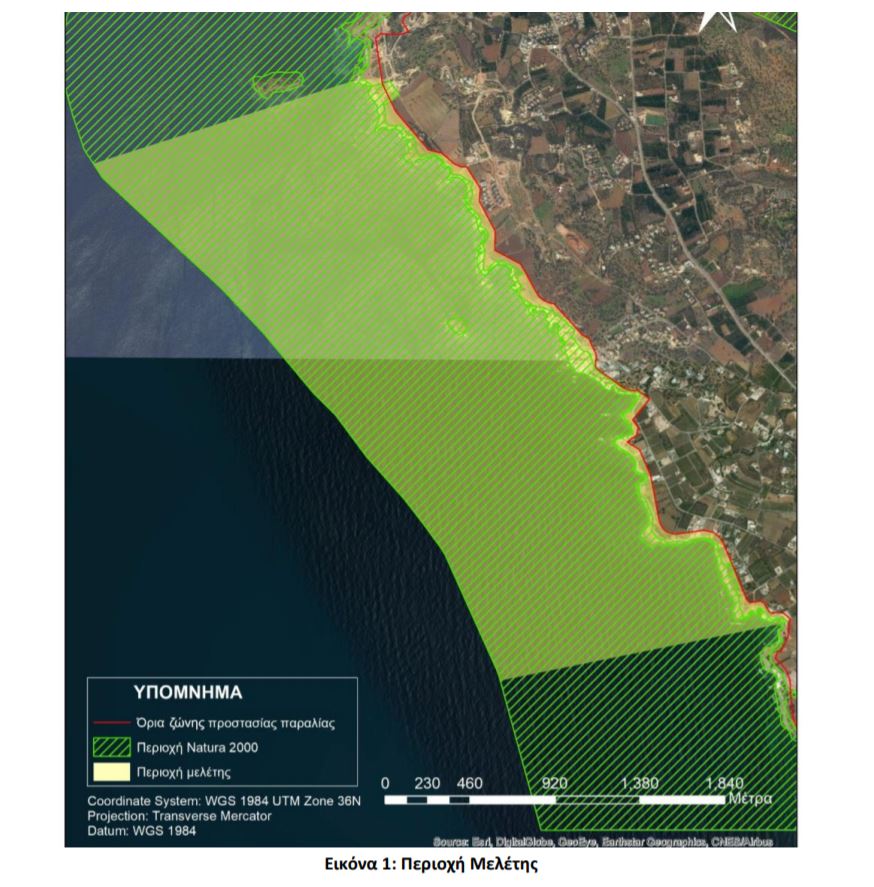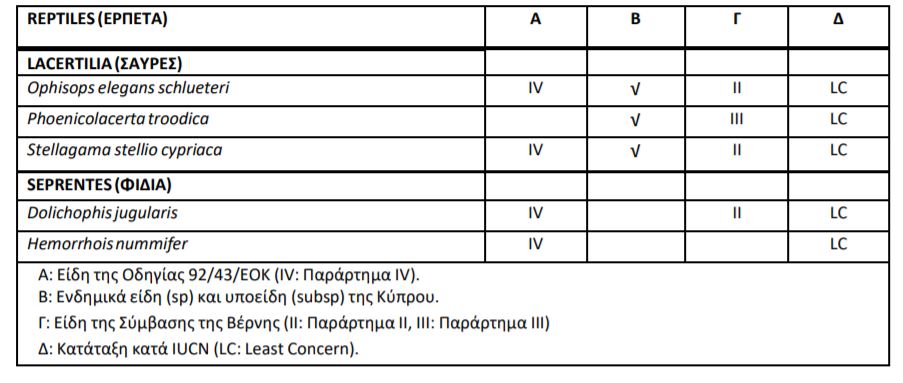An Environment Department study published on Thursday lists the species in the area of the Peyia sea caves and sets out a number of recommendations for the protection of its natural habitat.
The study found that flora and fauna of the area are negatively affected by construction and artificial lighting in the area.
An area of 206,65 hectares containing natural habitats such as marine vegetation, reefs, the sea caves, as well as flora and fauna”are not in a good condition due to anthropogenic disturbances and they are mostly fragmented,” the study said.
The area of study:

Flora in the Peyia sea caves area:
The study found that there are 41 species of flora in the area. Three of them are endemic to Cyprus, one of them (aizoon hispanicum) is listed as endangered and another one as vulnerable (taraxacum aphrogenes).

Fauna in the Peyia sea caves area:
According to the study there are nine species of mammals in the area, five species of reptiles, while two species of migratory birds (Oenanthe cypriaca and Sylvia melanothorax) use the area for feeding and nesting.
The most important species of fauna in the area is the Mediterranean Monk seal (Monachus monachus), which is listed as endangered in the IUCN Red List of Threatened Species and is the most endangered marine mammal in Europe. Currently, there are only 14 Mediterranean Monk seals in Cyprus.
Specifically, the study found that a species of fox (Vulpes vulpes) lives in the area, a species of hedgehog (Hemiechinus auritus dorotheae), a species of mouse (Mus musculus) and a species of rat (Rattus rattus).
There are also four species of chiroptera (bat). Of these, three species (Hypsugo savii, Myotis blythii – 15 individuals recorded in the area – and Pipistrellus kuhlii) are listed as of Least Concern by the IUCN and another one (Miniopterus schreibersii – 120 individuals recorded in the area) as Near Threatened.


Consequences of human activity on Peyia sea caves habitat and flora
According to the study, the natural habitat of the area is in a bad condition due to anthropogenic disturbances such as walking, the movement of vehicles and touristic development.
The habitat is also affected by arbitrary human interventions in the protected area and the spreading of invasive flora species.
The study suggests that “authorities should control any interventions and developments, especially in the Natura 2000-protected area and must ensure the restoration of the natural habitat of the study area.”
This will be achieved by monitoring the uncontrolled movement of people and vehicles inside the Natura 2000-protected area and by the removal of invasive species, it said.
Consequences of human activity on Peyia sea caves fauna
“Due to its morphology, the area is one of the best of the whole Cypriot coastline for the reproduction of the Mediterranean Monk seal,” the study says.
The biggest threats that fauna in the area faces are the downgrading of its natural habitat and disturbance.
A cafe-restaurant that has been built near one of the caves the seals use the most, causes nuisance to them. Also the seals are affected by visitors which many times enter the caves, the study found.
However, although a large part of land above the caves has been used for construction, it does not appear to affect the seals due to the altitude difference between the construction and the caves, it concluded.
Measures
In coordination with the Ministry of Agriculture, the Environment Department has decided on adopting 40 measures to protect the natural habitat of the area.
Some of them are:
- The installation of warning signs to inform people that entrance to the caves is not allowed.
- The removal of foreign/invasive species from the area.
- For the green spaces of any future constructions to be built along the protected area, facing towards the sea in order to create a larger security zone from the sea caves. At the same time, land owners should not be allowed to buy these green spaces as part of a development.
- In cases where the protection zone has been “narrowed” due to erosion and/or urban planning, the government should consider extending the zone to the maximum permitted limit (100 yards), especially near the caves.
Although the Department deems most of the measures as positive, it suggests that the following are immediately adopted:
- Creation of an Absolute Protection Zone around the sea caves which the seals use for reproduction.
- Creation of a zone where the circulation of sea vessels will be monitored.
- Creation of a stone enclosure, parallel to the pedestrian route in order to prevent visitors from jumping to enter the caves.
- Strict control of future construction on the plots that are not developed.
- The expropriation of the plots that are directly above the caves in order to prevent new construction.
- Creation of ‘light’ construction on the above plots which will serve as information points for the importance of the Mediterranean Monk seal.
- Construction of a pedestrian route leading to Maniki and Kafizi beaches to control the movement of people and discourage them from using the caves to reach the beaches.
- Avoid projecting heavy lighting towards the sea and especially towards the caves.
- Organise information campaigns and environment training for the public and schools in the area.
- Application of a scientific system to monitor the seals. This includes the installation of infrared cameras in the caves and annual visits by scientists in set periods of time.
Read more:
https://in-cyprus.com/agriculture-ministry-bans-fishing-and-movement-of-vessels-in-peyia-sea-caves-area/






